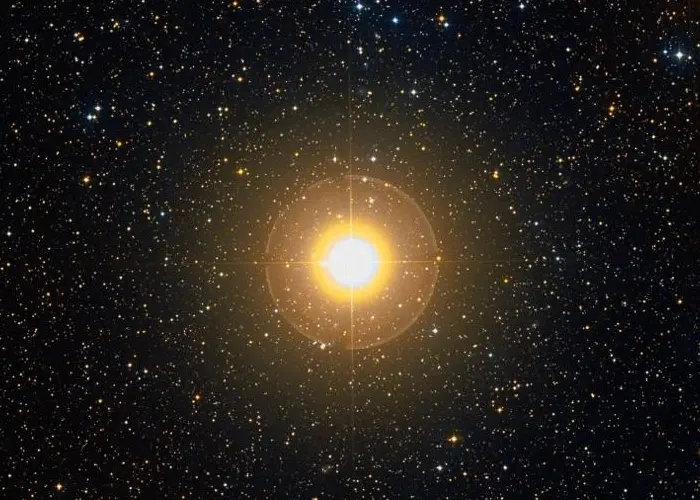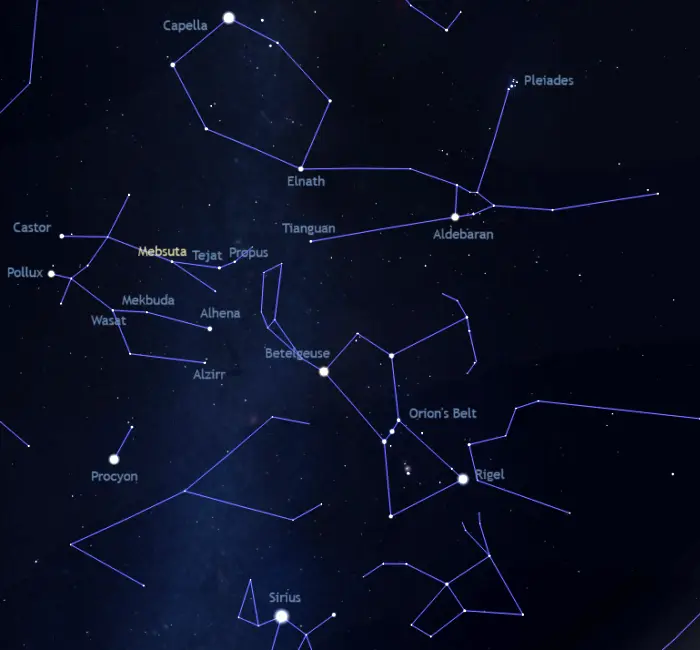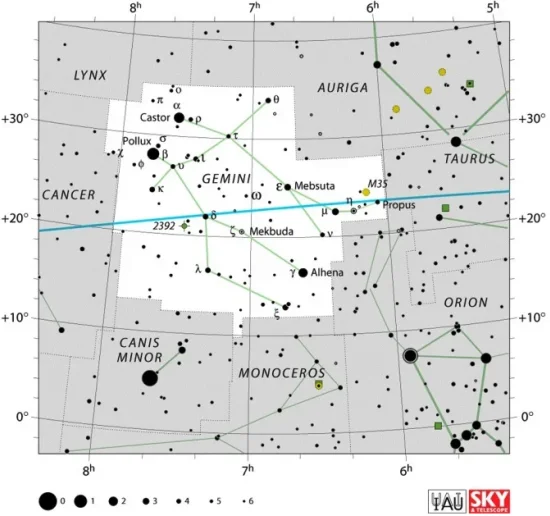Mebsuta, Epsilon Geminorum (ε Gem) is a yellow supergiant star located approximately 840 light-years away in the constellation Gemini. With an apparent magnitude of 3.06, it is the fifth brightest star in Gemini, after Pollux, Castor, Alhena, and Tejat. In the constellation figure of the Twins, the supergiant marks Castor’s leg.
Star type
Mebsuta is a yellow supergiant of the spectral type G8 Ib. With a mass 19.2 times that of the Sun, the star is a supernova candidate. It has a radius about 140 times that of the Sun – comparable to the orbit of Venus – and shines with 8,500 solar luminosities. The star has an estimated surface temperature of 4,662 K and spins at 8.7 km/s.
Mebsuta is believed to be about 8.3 million years old. Even though it is a young star, it has already burned through its supply of hydrogen and evolved away from the main sequence due to its high mass. It will not be long (astronomically speaking) before it goes out as a brilliant supernova.

Mebsuta (Epsilon Geminorum), image: Wikisky
Epsilon Geminorum is a suspected variable star. It is listed as CSV 100759 in the Catalogue of Suspected Variable Stars and as NSV 3183 in the New Catalogue of Suspected Variable Stars. The American Association of Variable Star Observers (AAVSO) lists the star as AAVSO 0637+25.
Mebsuta has a magnetic field with a strength of –0.14 ± 0.19 G on its surface. The field was detected during observations with the Canada-France-Hawaii Telescope in 2010. It is believed to be the result of a deep convection zone in the outer atmosphere of the star.
The supergiant has an optical companion, a K-type main sequence star. The star is unlikely to be a physical companion to the more massive Mebsuta.
Facts
Mebsuta has served as a spectral standard for its class (G8 Ib) since 1943. The star’s spectrum is one of the stable anchor points used to classify other stars. The hotter yellow supergiant Sadalsuud in the constellation Aquarius is a spectral standard for the class G0Ib.
Mebsuta lies near the ecliptic (the apparent path of the Sun and the planets across the sky) and can be eclipsed by the Moon and planets. It was occulted by Mars on April 8, 1976. The event allowed astronomers to measure the oblateness of the outer atmosphere of the red planet. Epsilon Geminorum was also eclipsed by the planet Mercury on June 10, 1940, and by the asteroid Iphigenia on September 3, 2015.
Name
The name Mebsuta (pronunciation: /mɛbˈsuːtə/) comes from the Arabic ‘Mabsūṭah, meaning “the outstretched paw.” The name refers to the outstretched paw of a lion. The star was historically also known as Mebusta, Mesoula, Mibwala, Menita, Melucta, and Melboula.
In ancient Arabic astronomy, Mebsuta and Mekbuda represented the paws of a lion. The lion (Asad) covered a third of the sky and did not correspond to the modern constellation Leo. Regulus in Leo marked its forehead, the stars of Corvus its hind quarters, and Arcturus and Spica its shin bones. Castor and Pollux represented one of the forepaws and the stars of Canis Minor the other.
The name Mebsuta was approved for ε Geminorum by the International Astronomical Union’s (IAU) Working Group on Star Names (WGSN) on July 20, 2016.
In Chinese astronomy, Epsilon Geminorum was known as 井宿五 (Jǐng Su wǔ), the Fifth Star of Well. It formed the Well asterism with Tejat (Mu Geminorum), Nu Geminorum, Alhena (Gamma Geminorum), Alzirr (Xi Geminorum), 36 Geminorum, Mekbuda (Zeta Geminorum), and Lambda Geminorum. The Well asterism was part of the larger Well mansion, one of the southern mansions of the Vermilion Bird.
Location
Mebsuta is relatively easy to identify because it is part of the conspicuous constellation figure of the celestial Twins. The star lies in the region between the bright Capella in the constellation Auriga and Procyon in Canis Minor. It can be found by following the line of the Bull’s southern horn, from Aldebaran through Tianguan, which points towards Castor’s leg. Mebsuta is the brightest star between Castor and Tejat. Castor marks the head of Castor and Tejat and Propus mark one of the Twin’s feet.
The bright open cluster Messier 35 lies just north of the imaginary line connecting Mebsuta in Gemini and Tianguan in Taurus, near Propus at Castor’s foot.

Mebsuta location, image: Stellarium
Constellation
Mebsuta is located in the northern constellation of Gemini. Representing the mythical twins Pollux and Castor, Gemini is one of the 48 Greek constellations that were catalogued by the astronomer Claudius Ptolemy in his Almagest in the 2nd century CE.
Gemini occupies 514 square degrees of the northern sky and is the 30th largest constellation in the sky. It is one of the brighter zodiac constellations. It is home to Pollux (Beta Geminorum) and Castor (Alpha Geminorum), the 17th and 23rd brightest stars in the sky. The stars mark the heads of the celestial Twins.
Other interesting stars in Gemini include the spectroscopic binary system Gamma Geminorum (Alhena), the red giants Tejat (Mu Geminorum) and Propus (Eta Geminorum), the variable supergiant Mekbuda (Zeta Geminorum), the dwarf nova U Geminorum, and the triple star system Delta Geminorum (Wasat). The constellation is also home to Geminga, a gamma ray and X-ray source believed to be a neutron star.
Deep sky objects in Gemini include the open clusters Messier 35, NGC 2129, NGC 2158, NGC 2266, and NGC 2355, the supernova remnant IC 443 (the Jellyfish Nebula), and the planetary nebulae NGC 2392 (the Clown Face Nebula) and the Medusa Nebula (Sh2-274).

Gemini constellation map by IAU and Sky&Telescope magazine
The best time of the year to observe the stars and deep sky objects in Gemini is during the month of February, when the constellation appears higher above the horizon in the early evening. The entire constellation is visible from locations north of the latitude 60° S.
The 10 brightest stars in Gemini are Pollux (Beta Gem, mag. 1.14), Castor A (Alpha Gem A, mag. 1.93), Alhena (Gamma Gem, mag. 1.9), Tejat (Mu Gem, mag. 2.86), Castor B (Alpha Gem B, mag. 2.97), Mebsuta (Epsilon Gem, mag. 3.06), Propus (Eta Gem A, mag. 3.15 – 3.90), Alzirr (Xi Gem, mag. 3.35), Wasat (Delta Gem, mag 3.53), and Kappa Geminorum (mag. 3.568).
Mebsuta – Epsilon Geminorum
| Spectral class | G8 Ib |
| Variable type | Suspected |
| U-B colour index | +1.46 |
| B-V colour index | +1.40 |
| Apparent magnitude | 3.06 |
| Absolute magnitude | -3.90 |
| Distance | 840 ± 40 light-years (260 ± 10 parsecs) |
| Parallax | 3.86 ± 0.17 mas |
| Radial velocity | +7.77 ± 0.23 km/s |
| Proper motion | RA: –5.57 ± 0.24 mas/yr |
| Dec.: −12.36 ± 0.13 mas/yr | |
| Mass | 19.2 ± 0.1 M☉ |
| Luminosity | 8,500 L☉ |
| Radius | 140 ± 35 R☉ |
| Temperature | 4,662 ± 36 K |
| Metallicity | 0.15 ± 0.07 dex |
| Age | 8.3 ± 0.1 million years |
| Rotational velocity | 8.7 ± 1.0 km/s |
| Surface gravity | 0.88 ± 0.05 cgs |
| Constellation | Gemini |
| Right ascension | 06h 43m 55.9262590s |
| Declination | +25° 07′ 52.051484″ |
| Names and designations | Mebsuta, Epsilon Geminorum, ε Gem, 27 Geminorum, HD 48329, HR 2473, HIP 32246, SAO 78682, FK5 254, BD+25 1406, AG+25 749, GC 8786, GCRV 4372, JP11 1421, PLX 1567, PPM 96453, UBV 6652, UBV M 12365, UBV M 12373, IRAS 06408+2510, 2MASS J06435593+2507520, AAVSO 0637+25, CSV 100759, NSV 3183, TYC 1897-1639-1, Gaia DR2 3384529341302241536, ADS 5381 A, CCDM J06440+2508A, IDS 06378+2514 A, WDS J06439+2508A |